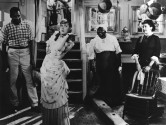
Within Our Gates
Screening on Film
With Evelyn Preer, Flo Clements, James D. Ruffin.
US, 1920, 35mm, black & white, silent, 80 min.
Print source: Library of Congress
Thought lost until a single surviving print was rediscovered in Spain, Oscar Micheaux’s Within Our Gates may be the legendary director’s most provocative film. Made in response to the racism portrayed in D. W. Griffith's The Birth of a Nation, Within Our Gates contains sequences deemed so incendiary that the film was repeatedly cut by censors. In 1992 the Library of Congress restored the film as close to the original as possible. Micheaux’s melodrama follows Sylvia, a young Southern teacher who travels to Boston to seek funding for her school. An extended flashback near the end of the film “refute[s] the claims of white popular culture with regard to ‘black’ Reconstruction” (Michele Wallace),” showing us how Sylvia’s life was shaped by racial prejudice, lynching, and miscegenation.
PRECEDED BY
-
The House of Darkness
Directed by D.W. Griffith.
With Lillian Gish, Lionel Barrymore, Charles Hill Mailes.
US, 1913, 35mm, black & white, 17 min.
Griffith's role in establishing the feature as the dominant mode of American film production is widely celebrated. It was in the short form—Griffith made 450 shorts at Biograph between 1908 and 1913—that Griffith and cinematographer Billy Bitzer developed the cinematic language of Classical Hollywood. In this one-reel drama, Griffith addresses the social problem of mental illness, and music's healing power. With its use of movement within the frame and off-screen space, The House of Darkness demonstrates "the increased sophistication of Griffith and Bitzer's camerawork at the end of the Biograph period" (Tom Gunning).





















